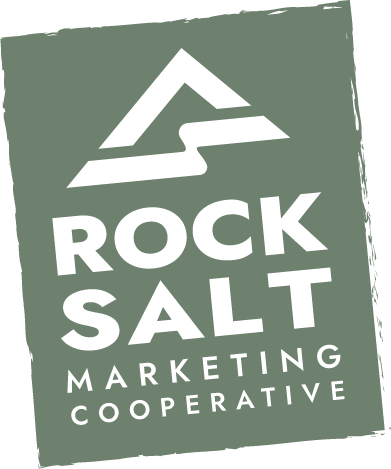Website design, web development, and search engine optimization (SEO) are separate but critical contributors to a website’s online performance. A website can provide a user with the most visually stunning and functional of experiences, but if it’s not optimized for search engines, that user will probably never see it in the first place. On the other hand, a visually disappointing and unnavigable website won’t reach its full potential even if traffic is flowing to it from search engines. When it comes to web design and SEO services, you really shouldn’t invest in one without the other.
However, many business owners and internal marketing teams have discovered that building an SEO-friendly website can be an extremely frustrating process because it’s difficult to find a web team that effectively implements SEO principles in their builds, and it can be equally challenging to find an SEO agency that excels in website design and development. The truth is, the vast majority of web designers and developers have little to no knowledge of SEO best practices—and they shouldn’t necessarily be expected to. It would, of course, be helpful for them to brush up on SEO, but asking web designers and developers to be experts at SEO is like expecting an architect or home builder to also be an effective realtor; all of these jobs are critical to making a home appealing to a buyer, but they play separate roles in getting a home sold. On the flip side, while (reputable) SEOs are required to know the effects of web design and website functionality on keyword rankings, traffic acquisition, and lead generation, they very rarely have the technical training required to implement the necessary changes themselves.
These realities often lead businesses to seek out two separate teams and coordinate between them to execute a successful website build. More often, however, companies invest in having their website built first and then hire a digital marketing team to come in and “SEO” it. Each of these approaches presents a series of issues and challenges. In this article, my goal is to help business owners, internal marketing teams, project managers, and website professionals navigate these obstacles so you can achieve your desired result: a sleek, highly functional, and modern website that also performs exceptionally well on Google. I’ll also outline how to avoid paying for your site to be optimized for SEO after the site is launched and, instead, have the site optimized as part of its initial build cost. My recommendations were cultivated through my experience optimizing thousands of websites for organic search performance and planning and executing countless website builds and site migrations, including for some household name Fortune 500 companies. But before I pass on my recommendations, it’s important for me to provide a few definitions to make sure we’re on the same page.
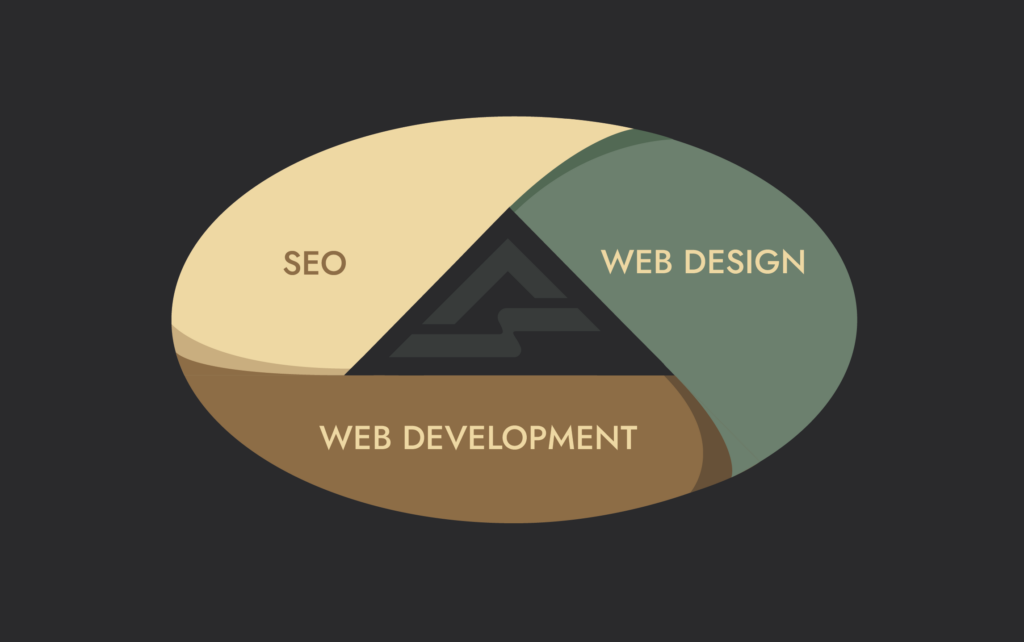
Website Design, Web Development, and SEO: What’s the Difference?
In this article, I’ll frequently refer to three critical components of the website production process: website design, website development, and SEO. People who aren’t fully immersed in the website and digital marketing industries often conflate these three processes, so it’s important to highlight their distinctions before moving forward. Here are some basic definitions:
What is web design?
Website design is one of the very first steps in bringing a new website to life. A web designer dreams with the website owner and brings their ideas into visual reality while adhering to modern best practices for visual design. Using tools like Figma, Canva, Adobe Illustrator, Adobe Photoshop, Adobe Stock, and more, a web designer mocks up a visual (and, nowadays, semi-functional) representation of the website-to-be. This representation of the website is not yet live on the internet and merely serves to bring the business owner and all teams involved in the new site’s production into accordance on how the final result should look and function. Once all parties are satisfied with the future website’s design, the site can move into its development phase.
What is web development?
Website development is the process of translating a website’s design into functional reality. A web developer, or team of developers, builds a staging site that is ideally a 1:1 representation of the designer’s blueprints, but complete with its intended functionality. Once the staging site is developed, it’s a bona fide website that’s live on the internet. It’s always recommended, however, to make a staging site non-indexable to keep search engines and users from finding it before it’s ready for its audience. For many websites, it’s also advisable to keep the staging site password-protected during its development phase.
What is SEO in web design and development?
While SEO is the last definition I’m providing here, it’s by no means the last step in a multi-step process; SEO should be a primary consideration throughout the web design, web development, and post-launch phases of a website’s life. Search engine optimization is the enhancement of a website to support its discoverability on popular search engine platforms like Google, Bing, Yahoo, DuckDuckGo, and nowadays, AI software. SEO professionals—often referred to as SEO experts, SEO specialists, SEO technicians, or simply SEOs—improve a website’s structure, technical performance, and content to help searchers find it online. Of course, there are important off-site factors that impact a site’s SEO performance, but this article specifically touches on how SEO is related to website design and development.
7 Steps To Building A Modern, SEO-Friendly Website
Because web designers, web developers, and SEO experts specialize in individual phases of the site build process, the coordination required to execute a stunning website—that’s at the same time search-ready—can prove difficult to harness. The key to a successful website, at least in terms of organic search performance, is to keep the SEO team involved in each phase of the site’s development. For that reason, as part of each step below, I’ve outlined the main SEO considerations everyone involved with the site build should keep in mind throughout the process. Here are 7 steps your SEO, web design, and web development teams can follow to launch a pristine website that’s visually appealing and easily discoverable online:

1. Keyword Research
The production of any website that’s intended to attract organic traffic should begin with exhaustive keyword research. Detailed keyword research should inform fundamental aspects of the new site build, such as the types of pages that should be included in the website’s architecture as well as the orientation and amount of copy on each page.
For example, search volume and intent data uncovered during keyword research can inform a lawyer in Houston, TX, that their website should include both a service page outlining their immigration law services and an informational blog post detailing the intricacies of Texas’ immigration laws. Keyword research can also reveal to a home renovation contractor franchise what cities their audience is searching for their services in, which should underpin their strategy on the service area pages to include in their sitemap plan (next step).
Moreover, comprehensive keyword research should orient the implementation of key ranking signals in your website copy, such as each page’s metadata and H1 headers, internal link strategy (including the links’ anchor text), and image alt text, to name a few. In short, any website project that doesn’t begin with skilled keyword research will not result in an intentional, search-ready website.
Main SEO Considerations
- What keyword rankings would help the business achieve its goals?
- What search terms is the business’s target audience using to find relevant products/services?
- What types of pages would appropriately address each keyword’s search intent?
- Is there a legacy site with relevant existing content that would satisfy certain keywords and can be repurposed or optimized?
2. Sitemap Planning and 301 Redirect Mapping
Planning a website’s sitemap is a critical next step for the SEO team before a designer begins creating mockups. This process ensures the site is set up for optimal crawlability and user experience from the start. A well-organized website structure is a key SEO factor, influencing everything from how search engines index the site to how users navigate it. At Rock Salt Marketing, our SEOs take the lead in outlining the site’s framework and layout using Octopus, but any sitemap builder, website planner, or even spreadsheet software will do.
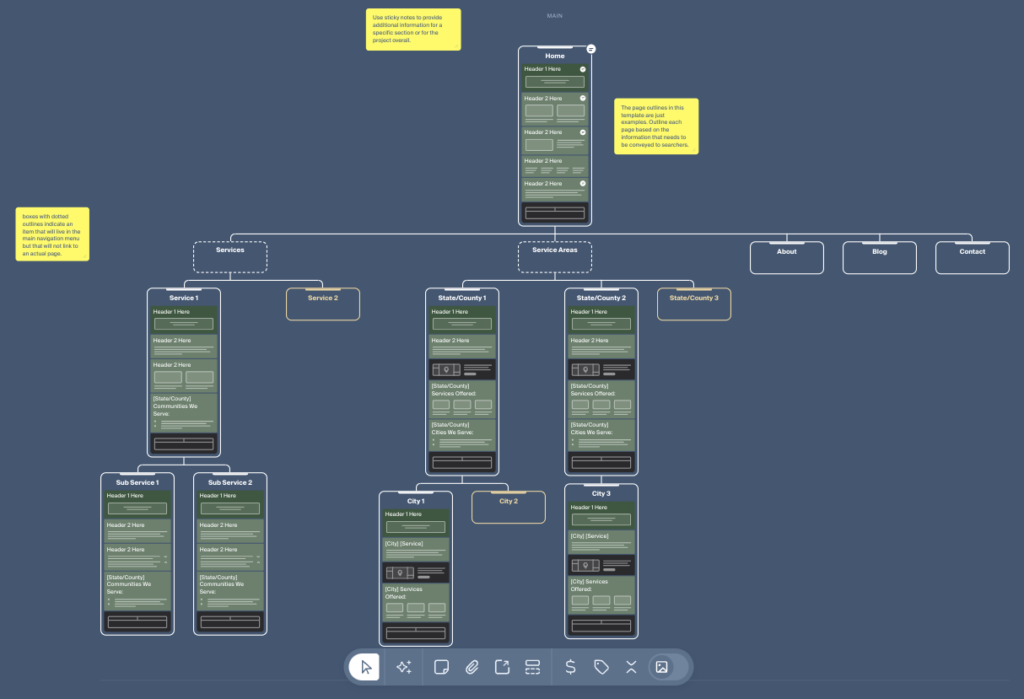
Our sitemap planning phase includes defining how each page should be segmented and providing the design team with recommended word counts for each section, ensuring the amount of content the site will need in order to rank well is incorporated into the design from the start. This is also a good time for the SEO team to outline URL structures (subfolder architecture) for each page as well as tentative section headers so the designer knows what each part of the page is intended to convey. Once the sitemap is passed off by your design team and agreed upon by all stakeholders, the project’s SEO experts can map out 301 redirects from old website pages to new pages if the new website is intended to replace another.
Creating a sitemap outline before moving the project into its web design phase ensures that the site’s design maintains its SEO integrity and won’t have to be significantly altered later in the development process to accommodate search performance. This way, the designer knows their parameters and can work unfettered by concerns that their work might have to be reconfigured down the line. This leaves the designer to do what they do best: be creative.
Main SEO Considerations
- Can search engines and users reach all important pages within just a few clicks from the site’s homepage?
- Is the site’s navigation intuitive and well-organized?
- Does each page flow well and still include enough space to address searchers’ questions with written copy?
- Have you planned the structure of each page’s URL (subfolder paths) to reflect the site’s intuitive navigation and include keywords?
- Are all valuable legacy pages planned for with 301 Redirects?
3. Website Design & SEO
As a designer mocks up the new website, an SEO should inform a few aspects of the design beyond just the site’s general layout and structure. An SEO should monitor a few additional SEO-related aspects of the website design, such as device responsiveness, content accessibility, and content density. Of course, expert web designers hold these principles just as close to their hearts as SEOs do, if not closer.
Any modern website should be responsive on devices other than just desktop computers, including mobile phones, tablets, and laptops of various sizes. Content should be readable and easy to engage with on any machine your viewers visit your site with. The site should also be accessible to all categories of users. For example, the colors and sizes of fonts, contrast between text and backgrounds, and images should be chosen with visually impaired visitors in mind. Accessibility for visually impaired users is also a factor in SEO-friendly website development, which involves tagging images with alt text to enable these visitors to enjoy your site with the use of a screen reading device. We’ll cover this more in the next step.
Main SEO Considerations
- Is the website responsive on all devices, including mobile phones?
- Can all users, within reason, access and engage with your site content?
- Does the website design allow for enough written copy to address searchers’ questions?
- Does the design call attention to important calls-to-action?
4. Website Development & SEO
After completing keyword research, sitemap planning, and website design, the next stage of the website project is bringing these plans to life. Developers can begin building out the site while copywriters simultaneously create high-quality, search-optimized content based on your keyword research findings. This parallel workflow ensures both the developed website structure and the content that will fill it are ready at around the same time, streamlining the process and maximizing efficiency. While this dual process is highly efficient, your SEOs will need to be agile enough to oversee the search-related components of both initiatives at the same time.
Search performance should be a central consideration in both the functional and content components of the website’s development. On the functional side, your SEO experts should champion technical website performance factors such as site speed, content stability, schema markup, site security, and indexability. The site’s files should be cached efficiently, and its code can be minified to yield quick load speeds. You can also use optimal multimedia file formats such as the .webp format for images and the .mp4 format for videos. LazyLoading these file types can also go a long way in improving site speed. Other core web vitals, like layout shift, can significantly impact rankings. Your SEOs should ensure that buttons, links, and search bars don’t shift as you’re trying to engage with them. Furthermore, the website’s indexability and intelligibility (to search engines) are influenced by a few additional technical components that your SEO team should address. Your SEO specialists should optimize canonical tags, structured data, and your sitemap.xml and robots.txt files to make sure Google interprets your content as intended. Some of my favorite tools for accomplishing these tasks include Cloudflare’s CDN and their other tools like Zaraz and Polish, WP Rocket, Imagify, and Yoast.
SEO is even more crucial when it comes to copywriting. Each page of copy should include an optimized meta title, meta description, and H1 header. The keywords that your SEO technicians mapped out for each page should also be incorporated naturally into the page’s prose. If you can get away with it without the copy reading inorganically, about 3–5 instances per 500 words is a good keyword density. The content should be structured in an easily digestible format, segmented by H2, H3, H4 headers, and so on. Bullet points, ordered lists, and images are other great ways to render your copy more digestible and engaging.
Additionally, internally linking between important pages on your site is a great practice. This allows users and search engine crawlers to navigate through your website with ease and also helps search engines understand the relationships between different topics on your site. Well-placed internal links also diffuse link authority between your pages, allowing them to rank more favorably. To accomplish link flow most effectively, use the keyword your referenced page is targeting in the link’s anchor text. Finally, each image used on your site should have alt text written for it to promote accessibility (visually impaired users can digest your images with the use of a screen reader) and increase its chances of ranking in image results.
Before we move on, a quick note on AI copywriting: While AI language models have made it incredibly simple for anyone to produce content en masse, quantity is not the name of the game. AI is very useful for teasing out ideas, finding synonyms, rewording phrases for clarity, or aiding with other small writing tasks, but it’s not a suitable replacement for a skilled human writer. And remember, the best “AI checkers” around are your eyes. If the copy doesn’t read naturally and isn’t as helpful as it could be, it’s not good enough for the search engines.
Main SEO Considerations
- Do all important pages on your site load quickly (at least faster than those of competitors)?
- Does the technical performance of the site lend itself to a good user experience?
- Have you used a sitemap.xml file, robots.txt file, canonicals, and schema markup to tell search engines how to parse your content?
- Are your keywords used optimally in each page’s metadata and on-page copy?
- Do your priority pages link to each other with an intentional strategy?
5. Pre-Launch QA
At this point, everyone involved with the site’s planning and development will either be very excited for its launch or ready for it to be over with. Either way, before launching your new website, you should conduct a thorough QA (quality assessment) process. Make sure all of the important web design and SEO considerations outlined in steps 1–4 have been addressed and that the website looks and functions as intended by the designer.
Your SEO team should also set up their tools to monitor the site’s performance. If it hasn’t already been done, your team should—at the very least—configure Google Analytics, Google Search Console, and keyword rank tracking. If you track phone calls with software like CallRail, this is a good time to install it on the site. If the new site is replacing an old one, you’ll want to compare traffic and keyword ranking data from these tools as well as technical performance metrics between the two sites. For technical performance reports and monitoring, I prefer to use GTmetrix and Google’s lighthouse.
Main SEO Considerations
- Is your performance tracking software installed and configured properly?
- Do you have performance data from your legacy site that can be compared with the new site?
- Are your contact forms, phone number buttons, and email address links functional?
6. Site Deployment
This is the exciting step in the website build process where you get to show all your hard work to searchers and search engines. There are, of course, many considerations for website developers to keep in mind as they push their staging site into a discoverable environment. Considering this article is more about the involvement of SEOs in the site build process, however, I’ll leave those topics for another time.
The primary role of your SEO team in website deployment is to make sure that the website is discoverable on search engines and that its content is pushed live with the team’s intended optimizations. Once a site is launched, your team should first check to make sure that the correct metadata, H1 headers, and copy are present on the site. Your SEOs can then verify that 301 redirects are in place and are functioning properly. Following their content and redirect checks, your SEO team should confirm that the development team has rendered the site indexable (remember that the site was non-indexable through the development stage). At this point, test traffic and event tracking data using Google Analytics’ realtime report to make sure that your tracking tools are responding to user engagement.
If everything looks good on the live website, your team should proactively notify Google of your new website. For every site build, submit the site’s sitemap.xml file to Google Search Console for indexing. If the new site is replacing an old one and is also using a new site address (URL), submit this information to Search Console’s change of address tool. This process notifies Google about the site’s new content and, if applicable, its new site address.
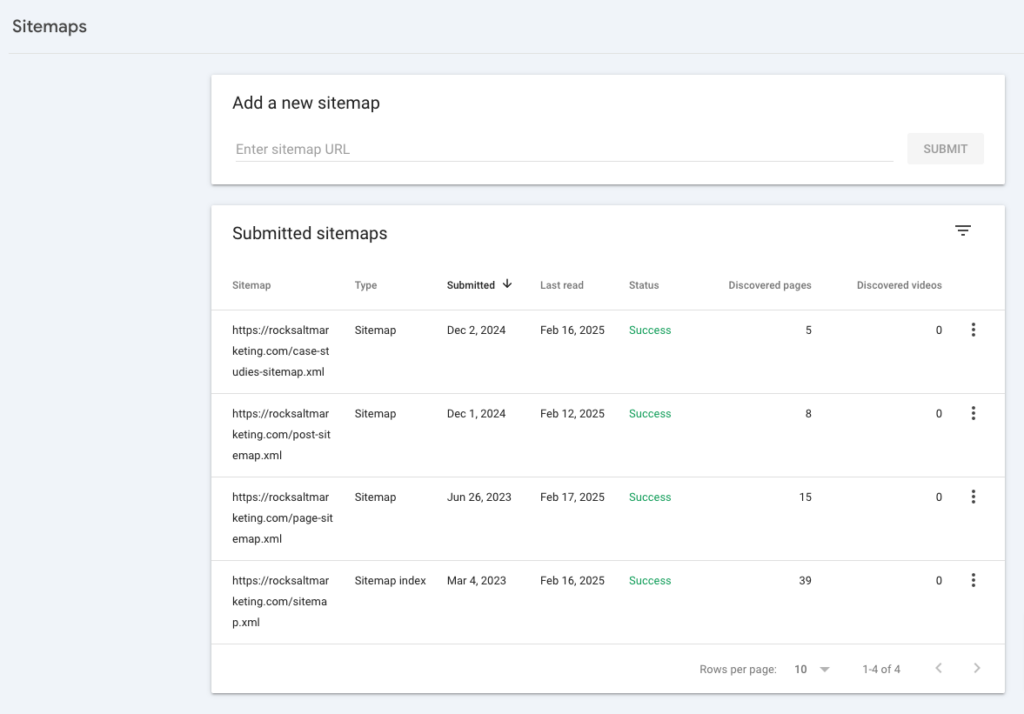
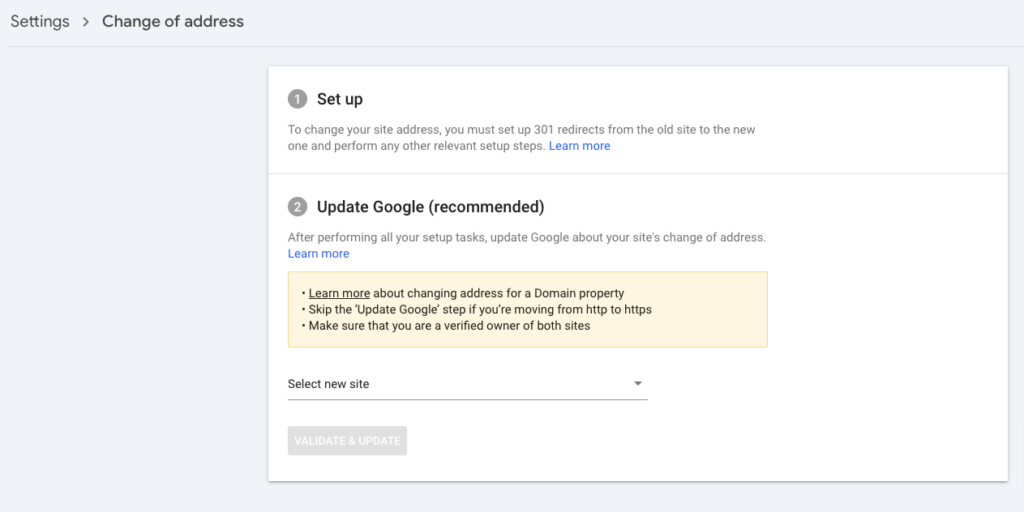
Main SEO Considerations
- Are the site’s metadata and H1 headers correct?
- Is the site’s content correct?
- Are 301 redirects functioning properly?
- Do contact forms and other methods of contact work correctly?
- Is the site indexable?
- Are traffic and events tracking properly in Google Analytics?
- Did you submit the site’s sitemap to Google Search Console?
7. Post-Launch Site Monitoring & Improvement
It may go without saying, but SEO is not a set-it-and-forget-it task that only has to be done once. After your new site is live, your SEO experts should continue the ongoing process of search engine optimization by reacting to search engine algorithm updates, new competitors on the scene, developing business goals, and more. Your team should closely monitor keyword ranking progress, website traffic, and user engagement events for the lifetime of your website. It’s also recommended that you track your website’s technical performance (with tools like GTmetrix and Google Search Console, as mentioned above) and maybe even set up a recurring site audit in Semrush, Ahrefs, or your software of choice.
As your team notices changes in search performance, whether good or bad, they should report on those developments and present their plans of action. Nevertheless, SEO is not solely a reactionary process. A good SEO strategy consists of continued growth through consistent content publication and high-quality backlink acquisition. Both of these tasks should always be informed by sound keyword research data—from the research conducted prior to site launch and additions to your research made later.
Main SEO Considerations
- Are you monitoring keyword rankings, traffic, and conversion events and adjusting strategy according to your findings?
- Are you tracking technical website performance and maintaining both indexability and a favorable user experience on your site?
- Is your team continuously producing high-quality onsite content and backlinks to support it?
Build a Cutting-edge, Trail-ready Website with Rock Salt Marketing
The Rock Salt team prides ourselves in building elegant websites that are not only anchored in current best practices for design and functionality but are also grounded in exhaustive research and are equipped for optimal search visibility. Every website we build is crafted with the expert guidance of our Utah SEO team, the unmatched creativity of our web design team, and the technical prowess of our award-winning website developers, culminating in unparalleled web design and SEO services. With Rock Salt Marketing, you don’t have to coordinate between different teams to produce your dream website, and you certainly don’t have to pay additional fees to have your new website “SEO’d” after it’s built; no website gets published on our watch without the Rock Salt SEO stamp of approval. If you need a reliable SEO and website development partner to manage your post-launch site monitoring and improvement, we can do that too. Contact our Salt Lake City digital marketing experts to start building your modern, search-friendly website today!




